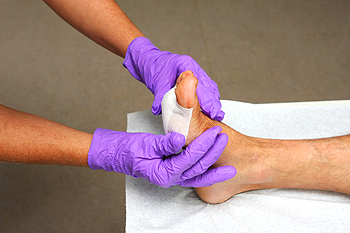
Shoe chafing and pain can ruin your day, but a few simple tricks can help. Start by keeping your feet dry as moisture increases friction. Use liner socks or cushioned heel socks for extra protection. Insoles can be a game-changer by adjusting heel height and improving fit. Care for your shoes by ensuring they are clean and well-maintained. Worn-out shoes often cause discomfort, and proper lacing is key to securing your feet without excessive tightness. To reduce pressure, gently soften tough areas in your shoes with tools like a shoe stretcher or a bit of heat. If you notice redness, irritation, or pain, stop wearing the offending shoes immediately to prevent foot wounds. Persistent issues could lead to blisters or infections. If you are experiencing persistent discomfort from shoe chafing, it is suggested that you schedule an appointment with a podiatrist who can assess your feet, and offer effective relief solutions.
Wound care is an important part in dealing with diabetes. If you have diabetes and a foot wound or would like more information about wound care for diabetics, consult with one of our podiatrists from Cascade Foot Clinic. Our doctors will assess your condition and provide you with quality foot and ankle treatment.
What Is Wound Care?
Wound care is the practice of taking proper care of a wound. This can range from the smallest to the largest of wounds. While everyone can benefit from proper wound care, it is much more important for diabetics. Diabetics often suffer from poor blood circulation which causes wounds to heal much slower than they would in a non-diabetic.
What Is the Importance of Wound Care?
While it may not seem apparent with small ulcers on the foot, for diabetics, any size ulcer can become infected. Diabetics often also suffer from neuropathy, or nerve loss. This means they might not even feel when they have an ulcer on their foot. If the wound becomes severely infected, amputation may be necessary. Therefore, it is of the upmost importance to properly care for any and all foot wounds.
How to Care for Wounds
The best way to care for foot wounds is to prevent them. For diabetics, this means daily inspections of the feet for any signs of abnormalities or ulcers. It is also recommended to see a podiatrist several times a year for a foot inspection. If you do have an ulcer, run the wound under water to clear dirt from the wound; then apply antibiotic ointment to the wound and cover with a bandage. Bandages should be changed daily and keeping pressure off the wound is smart. It is advised to see a podiatrist, who can keep an eye on it.
If you have any questions, please feel free to contact our offices located in Bend and Redmond, OR . We offer the newest diagnostic and treatment technologies for all your foot care needs.
